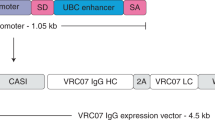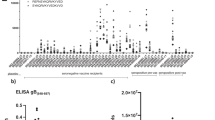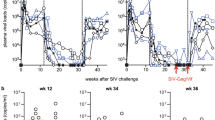Abstract
The ability of transient immunosuppression with a combination of a non-depleting anti-CD4 (NDCD4) antibody and cyclosporine (CyA) to abrogate immune reactivity to both adeno-associated viral vector (AAV) and its transgene product was evaluated. This combination of immunosuppressants resulted in a 20-fold reduction in the resulting anti-AAV8 antibody titres, to levels in naïve mice, following intravenous administration of 2 × 1012 AAV8 vector particles per kg to immunocompetent mice. This allowed efficient transduction upon secondary challenge with vector pseudotyped with the same capsid. Persistent tolerance did not result, however, as an anti-AAV8 antibody response was elicited upon rechallenge with AAV8 without immunosuppression. The route of vector administration, vector dose, AAV serotype or the concomitant administration of adenoviral vector appeared to have little impact on the ability of the NDCD4 antibody and CyA combination to moderate the primary humoral response to AAV capsid proteins. The combination of NDCD4 and CyA also abrogated the humoral response to the transgene product, that otherwise invariably would occur, following intramuscular injection of AAV5, leading to stable transgene expression. These observations could significantly improve the prospects of using rAAV vectors for chronic disorders by allowing for repeated vector administration and avoiding the development of antibodies to the transgene product.
This is a preview of subscription content, access via your institution
Access options
Subscribe to this journal
Receive 12 print issues and online access
$259.00 per year
only $21.58 per issue
Buy this article
- Purchase on Springer Link
- Instant access to full article PDF
Prices may be subject to local taxes which are calculated during checkout





Similar content being viewed by others
References
Nathwani AC, Davidoff A, Hanawa H, Zhuo F, Vanin EF, Nienhuis AW . Factors influencing in-vivo transduction by recombinant adeno-associated viral vectors expressing the human factor IX cDNA. Blood 2001; 97: 1258–1265.
Nathwani AC, Davidoff AM, Hanawa H, Hu Y, Hoffer FA, Nikanorov A et al. Sustained high-level expression of human factor IX (hFIX) after liver- targeted delivery of recombinant adeno-associated virus encoding the hFIX gene in rhesus macaques. Blood 2002; 100: 1662–1669.
Manno CS, Arruda VR, Pierce GF, Glader B, Ragni M, Rasko J et al. Successful transduction of liver in hemophilia by AAV-Factor IX and limitations imposed by the host immune response. Nat Med 2006; 12: 342–347.
Flotte TR, Brantly ML, Spencer LT, Byrne BJ, Spencer CT, Baker DJ et al. Phase I trial of intramuscular injection of a recombinant adeno-associated virus alpha 1-antitrypsin (rAAV2-CB-hAAT) gene vector to AAT-deficient adults. Hum Gene Ther 2004; 15: 93–128.
Ross CJ, Twisk J, Bakker AC, Miao F, Verbart D, Rip J et al. Correction of feline lipoprotein lipase deficiency with adeno-associated virus serotype 1-mediated gene transfer of the lipoprotein lipase S447X beneficial mutation. Hum Gene Ther 2006; 17: 487–499.
Brantly ML, Chulay JD, Wang L, Mueller C, Humphries M, Spencer LT et al. Sustained transgene expression despite T lymphocyte responses in a clinical trial of rAAV1-AAT gene therapy. Proc Natl Acad Sci USA 2009; 106: 16363–16368.
Bainbridge JW, Smith AJ, Barker SS, Robbie S, Henderson R, Balaggan K et al. Effect of gene therapy on visual function in Leber′s congenital amaurosis. N Engl J Med 2008; 358: 2231–2239.
Ali RR, Reichel MB, De Alwis M, Kanuga N, Kinnon C, Levinsky RJ et al. Adeno-associated virus gene transfer to mouse retina. Hum Gene Ther 1998; 9: 81–86.
Snyder RO, Miao C, Meuse L, Tubb J, Donahue BA, Lin HF et al. Correction of hemophilia B in canine and murine models using recombinant adeno-associated viral vectors. Nat Med 1999; 5: 64–70.
Herzog RW, Yang EY, Couto LB, Hagstrom JN, Elwell D, Fields PA et al. Long-term correction of canine hemophilia B by gene transfer of blood coagulation factor IX mediated by adeno-associated viral vector. Nat Med 1999; 5: 56–63.
Nakai H, Yant SR, Storm TA, Fuess S, Meuse L, Kay MA . Extrachromosomal recombinant adeno-associated virus vector genomes are primarily responsible for stable liver transduction in vivo. J Virol 2001; 75: 6969–6976.
Nakai H, Wu X, Fuess S, Storm TA, Munroe D, Montini E et al. Large-scale molecular characterization of adeno-associated virus vector integration in mouse liver. J Virol 2005; 79: 3606–3614.
Inagaki K, Lewis SM, Wu X, Ma C, Munroe DJ, Fuess S et al. DNA palindromes with a modest arm length of greater, similar 20 base pairs are a significant target for recombinant adeno-associated virus vector integration in the liver, muscles, and heart in mice. J Virol 2007; 81: 11290–11303.
Davidoff AM, Gray JT, Ng CY, Zhang Y, Zhou J, Spence Y et al. Comparison of the ability of adeno-associated viral vectors pseudotyped with serotype 2, 5 and 8 capsid proteins to mediate efficient transduction of the liver in murine and nonhuman primate models. Mol Ther 2005; 11: 875–888.
Nathwani AC, Davidoff AM, Hanawa H, Hu Y, Lozier JN, Hoffer F . et al. Sustained high level expression of human FIX following liver targeted delivery of recombinant adeno-associated virus encoding the human FIX gene in rhesus macaques. Blood 2001; 98: 782a (abstract).
Nathwani AC, Gray JT, Ng CY, Zhou J, Spence Y, Waddington SN et al. Self complementary adeno-associated virus vectors containing a novel liver-specific human factor IX expression cassette enable highly efficient transduction of murine and nonhuman primate liver. Blood 2006; 107: 2653–2661.
Halbert CL, Standaert TA, Wilson CB, Miller AD . Successful readministration of adeno-associated virus vectors to the mouse lung requires transient immunosuppression during the initial exposure. J Virol 1998; 72: 9795–9805.
Wang L, Calcedo R, Wang H, Bell P, Grant R, Vandenberghe LH et al. The pleiotropic effects of natural AAV infections on liver-directed gene transfer in macaques. Mol Ther 2010; 18: 126–134.
Nathwani AC, Cochrane M, McIntosh J, Ng CY, Zhou J, Gray JT et al. Enhancing transduction of the liver by adeno-associated viral vectors. Gene Therapy 2009; 16: 60–69.
Chirmule N, Propert K, Magosin S, Qian Y, Qian R, Wilson J . Immune responses to adenovirus and adeno-associated virus in humans. Gene Therapy 1999; 6: 1574–1583.
Xiao W, Chirmule N, Schnell MA, Tazelaar J, Hughes JV, Wilson JM . Route of administration determines induction of T-cell-independent humoral responses to adeno-associated virus vectors [in process citation]. Mol Ther 2000; 1: 323–329.
Zhang Y, Chirmule N, Gao G, Wilson J . CD40 ligand-dependent activation of cytotoxic T lymphocytes by adeno- associated virus vectors In vivo: role of immature dendritic cells [in process citation]. J Virol 2000; 74: 8003–8010.
Chirmule N, Xiao W, Truneh A, Schnell MA, Hughes JV, Zoltick P et al. Humoral immunity to adeno-associated virus type 2 vectors following administration to murine and nonhuman primate muscle. J Virol 2000; 74: 2420–2425.
Ziller C, Stoeckel F, Boon L, Haegel-Kronenberger H . Transient blocking of both B7.1 (CD80) and B7.2 (CD86) in addition to CD40-CD40L interaction fully abrogates the immune response following systemic injection of adenovirus vector. Gene Therapy 2002; 9: 537–546.
Haegel-Kronenberger H, Haanstra K, Ziller-Remy C, Ortiz Buijsse AP, Vermeiren J, Stoeckel F et al. Inhibition of costimulation allows for repeated systemic administration of adenoviral vector in rhesus monkeys. Gene Therapy 2004; 11: 241–252.
Boumpas DT, Furie R, Manzi S, Illei GG, Wallace DJ, Balow JE et al. A short course of BG9588 (anti-CD40 ligand antibody) improves serologic activity and decreases hematuria in patients with proliferative lupus glomerulonephritis. Arthritis Rheum 2003; 48: 719–727.
Waldmann H, Adams E, Fairchild P, Cobbold S . Infectious tolerance and the long-term acceptance of transplanted tissue. Immunol Rev 2006; 212: 301–313.
Nathwani AC, Gray JT, McIntosh J, Ng CY, Zhou J, Spence Y et al. Safe and efficient transduction of the liver after peripheral vein infusion of self complementary AAV vector results in stable therapeutic expression of human FIX in nonhuman primates. Blood 2007; 109: 1414–1421.
Qin S, Cobbold SP, Pope H, Elliott J, Kioussis D, Davies J et al. ‘Infectious’ transplantation tolerance. Science 1993; 259: 974–977.
Bemelman F, Honey K, Adams E, Cobbold S, Waldmann H . Bone marrow transplantation induces either clonal deletion or infectious tolerance depending on the dose. J Immunol 1998; 160: 2645–2648.
Winsor-Hines D, Merrill C, O′Mahony M, Rao PE, Cobbold SP, Waldmann H et al. Induction of immunological tolerance/hyporesponsiveness in baboons with a nondepleting CD4 antibody. J Immunol 2004; 173: 4715–4723.
Ng CM, Stefanich E, Anand BS, Fielder PJ, Vaickus L . Pharmacokinetics/pharmacodynamics of nondepleting anti-CD4 monoclonal antibody (TRX1) in healthy human volunteers. Pharm Res 2006; 23: 95–103.
Zmonarski SC, Boratynska M, Madziarska K, Klinger M, Kusztel M, Patrzalek D et al. Mycophenolate mofetil severely depresses antibody response to CMV infection in early posttransplant period. Transplant Proc 2003; 35: 2205–2206.
Shaddy RE, Fuller TC, Anderson JB, Lambert LM, Brinkman MK, Profaizer T et al. Mycophenolic mofetil reduces the HLA antibody response of children to valved allograft implantation. Ann Thorac Surg 2004; 77: 1734–1739.
Benjamin R, Khwaja A, Singh N, McIntosh J, Meager A, Wadhwa M et al. Continuous delivery of human type I interferons (alpha/beta) has significant activity against acute myeloid leukemia cells in vitro and in a xenograft model. Blood 2007; 109: 1244–1247.
Streck CJ, Dickson PV, Ng CY, Zhou J, Gray JT, Nathwani AC et al. Adeno-associated virus vector-mediated systemic delivery of IFN-beta combined with low-dose cyclophosphamide affects tumor regression in murine neuroblastoma models. Clin Cancer Res 2005; 11: 6020–6029.
Herzog RW, Mount JD, Arruda VR, High KA, Lothrop Jr CD . Muscle-directed gene transfer and transient immune suppression result in sustained partial correction of canine hemophilia B caused by a null mutation. Mol Ther 2001; 4: 192–200.
Dobrzynski E, Fitzgerald JC, Cao O, Mingozzi F, Wang L, Herzog RW . Prevention of cytotoxic T lymphocyte responses to factor IX-expressing hepatocytes by gene transfer-induced regulatory T cells. Proc Natl Acad Sci USA 2006; 103: 4592–4597.
Fields PA, Arruda VR, Armstrong E, Chu K, Mingozzi F, Hagstrom JN et al. Risk and prevention of anti-factor IX formation in AAV-mediated gene transfer in the context of a large deletion of F9. Mol Ther 2001; 4: 201–210.
Peng B, Ye P, Blazar BR, Freeman GJ, Rawlings DJ, Ochs HD et al. Transient blockade of the inducible costimulator pathway generates long-term tolerance to factor VIII after nonviral gene transfer into hemophilia A mice. Blood 2008; 112: 1662–1672.
Miao CH, Ye P, Thompson AR, Rawlings DJ, Ochs HD . Immunomodulation of transgene responses following naked DNA transfer of human factor VIII into hemophilia A mice. Blood 2006; 108: 19–27.
Wang Z, Kuhr CS, Allen JM, Blankinship M, Gregorevic P, Chamberlain JS et al. Sustained AAV-mediated dystrophin expression in a canine model of Duchenne muscular dystrophy with a brief course of immunosuppression. Mol Ther 2007; 15: 1160–1166.
Mingozzi F, Hasbrouck NC, Basner-Tschakarjan E, Edmonson SA, Hui DJ, Sabatino DE et al. Modulation of tolerance to the transgene product in a nonhuman primate model of AAV-mediated gene transfer to liver. Blood 2007; 110: 2334–2341.
Benjamin RJ, Waldmann H . Induction of tolerance by monoclonal antibody therapy. Nature 1986; 320: 449–451.
Qin SX, Wise M, Cobbold SP, Leong L, Kong YC, Parnes JR et al. Induction of tolerance in peripheral T cells with monoclonal antibodies. Eur J Immunol 1990; 20: 2737–2745.
Cobbold SP, Adams E, Marshall SE, Davies JD, Waldmann H . Mechanisms of peripheral tolerance and suppression induced by monoclonal antibodies to CD4 and CD8. Immunol Rev 1996; 149: 5–33.
Calbo S, Delagreverie H, Arnoult C, Authier FJ, Tron F, Boyer O . Functional tolerance of CD8+ T cells induced by muscle-specific antigen expression. J Immunol 2008; 181: 408–417.
Lin SW, Hensley SE, Tatsis N, Lasaro MO, Ertl HC . Recombinant adeno-associated virus vectors induce functionally impaired transgene product-specific CD8+ T cells in mice. J Clin Invest 2007; 117: 3958–3970.
Gao GP, Alvira MR, Wang L, Calcedo R, Johnston J, Wilson JM . Novel adeno-associated viruses from rhesus monkeys as vectors for human gene therapy. Proc Natl Acad Sci USA 2002; 99: 11854–11859.
Gao G, Vandenberghe LH, Alvira MR, Lu Y, Calcedo R, Zhou X et al. Clades of adeno-associated viruses are widely disseminated in human tissues. J Virol 2004; 78: 6381–6388.
De BP, Heguy A, Hackett NR, Ferris B, Leopold PL, Lee J et al. High levels of persistent expression of alpha1-antitrypsin mediated by the nonhuman primate serotype rh.10 adeno-associated virus despite preexisting immunity to common human adeno-associated viruses. Mol Ther 2006; 13: 67–76.
Davidoff AM, Ng CY, Sleep S, McIntosh J, Azam S, Zhao Y et al. Purification of recombinant adeno-associated virus type 8 vectors by ion exchange chromatography generates clinical grade vector stock. J Virol Methods 2004; 121: 209–215.
Nathwani AC, Persons DA, Stevenson SC, Frare P, McClelland A, Nienhuis AW et al. Adenovirus-mediated expression of the murine ecotropic receptor facilitates transduction of human hematopoietic cells with an ecotropic retroviral vector. Gene Therapy 1999; 6: 1456–1468.
Nathwani AC, Hanawa H, Vandergriff J, Kelly P, Vanin EF, Nienhuis AW . Efficient gene transfer into human cord blood CD34+ cells and the CD34+CD38- subset using highly purified recombinant adeno-associated viral vector preparations that are free of helper virus and wild-type AAV. Gene Therapy 2000; 7: 183–195.
Acknowledgements
This work was supported by The Katharine Dormandy Trust, UK, Medical Research Council, UK, Department of Health's NIHR Biomedical Research Centre's funding award to UCLH/UCL, UK, NIHR programme grant A for Molecular and Tissue Engineering. The ASSISI Foundation of Memphis, the American Lebanese Syrian Associated Charities (ALSAC), National Heart, Lung, and Blood Institute (NHLBI) Grant HL073838.
Author information
Authors and Affiliations
Corresponding author
Ethics declarations
Competing interests
Hermann Waldmann and Stephen Cobbold are shareholders in TolerRx Inc. The other authors declare no conflict of interest.
Rights and permissions
About this article
Cite this article
McIntosh, J., Cochrane, M., Cobbold, S. et al. Successful attenuation of humoral immunity to viral capsid and transgenic protein following AAV-mediated gene transfer with a non-depleting CD4 antibody and cyclosporine. Gene Ther 19, 78–85 (2012). https://doi.org/10.1038/gt.2011.64
Received:
Revised:
Accepted:
Published:
Issue Date:
DOI: https://doi.org/10.1038/gt.2011.64
Keywords
This article is cited by
-
Immune profiling of adeno-associated virus response identifies B cell-specific targets that enable vector re-administration in mice
Gene Therapy (2023)
-
IgG-cleavage protein allows therapeutic AAV gene delivery in passively immunized MPS IIIA mice
Gene Therapy (2023)
-
Hepatotoxicity in Adeno-Associated Viral Vector Gene Therapy
Current Hepatology Reports (2023)
-
Comprehensive characterization and quantification of adeno associated vectors by size exclusion chromatography and multi angle light scattering
Scientific Reports (2021)
-
Immune-orthogonal orthologues of AAV capsids and of Cas9 circumvent the immune response to the administration of gene therapy
Nature Biomedical Engineering (2019)



